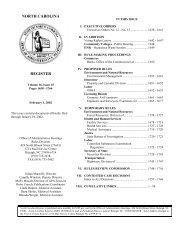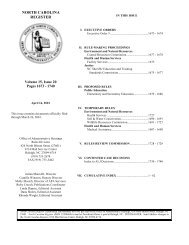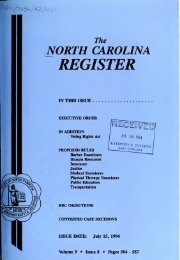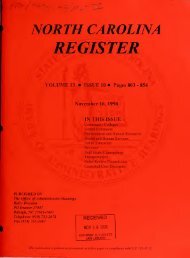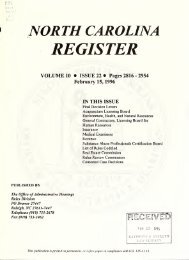NC Register Volume 9 Issue 15 - Office of Administrative Hearings
NC Register Volume 9 Issue 15 - Office of Administrative Hearings
NC Register Volume 9 Issue 15 - Office of Administrative Hearings
Create successful ePaper yourself
Turn your PDF publications into a flip-book with our unique Google optimized e-Paper software.
—structures— ©f<br />
—<br />
PROPOSED RULES<br />
cant should they be documented as<br />
a<br />
cultural resources;<br />
nui s ance to private property or to the<br />
public well being.<br />
"Nuisance" will be<br />
defined as any interference with rca<br />
sonable use <strong>of</strong> public trust areas or<br />
other lands within the ocean hazard<br />
system AECs that arc subject to<br />
lie<br />
{€)—The<br />
trust use.<br />
pub<br />
devices—w+H—be<br />
aligned no closer than 450 feet sea<br />
ward <strong>of</strong> the first line <strong>of</strong> stable natural<br />
vegetation or 300 feet from the mean<br />
high water line, whichever i s further<br />
s eaward.<br />
(3) (4) Beach Nourishment. Sand used for<br />
beach nourishment should be compatible<br />
with existing grain size and type.<br />
Sand to be used for beach nourishment<br />
shall be taken only from those areas<br />
where the resulting environmental<br />
impacts will be minimal.<br />
(4) (5)Beach Bulldozing. Beach bulldozing<br />
(defined as the process <strong>of</strong> moving natural<br />
beach material from any point seaward<br />
<strong>of</strong> the first line <strong>of</strong> stable vegetation<br />
to<br />
create a protective sand dike or<br />
to obtain material for any other purpose)<br />
is development and may be permitted<br />
as an erosion control measure if<br />
the following conditions are met:<br />
(A) The area on which this activity is<br />
being performed must maintain a<br />
slope <strong>of</strong> adequate grade so as to not<br />
endanger the public or the public's<br />
use <strong>of</strong> the beach and should follow<br />
the pre-emergency slope as closely as<br />
possible.<br />
The movement <strong>of</strong> material<br />
utilizing a bulldozer, front end loader,<br />
backhoe, scraper, or any type <strong>of</strong> earth<br />
moving or construction equipment<br />
should not exceed one foot in depth<br />
measured from the pre-activity surface<br />
elevation;<br />
(B) The activity must not exceed the<br />
lateral bounds <strong>of</strong> the applicant's property<br />
unless he has permission <strong>of</strong> the<br />
adjoining land owner(s);<br />
(C) Movement <strong>of</strong> material from seaward<br />
<strong>of</strong> the low water line will require a<br />
CAMA Major Development and State<br />
Dredge and Fill Permit;<br />
(D) The activity must not significantly<br />
increase erosion on neighboring properties<br />
and must not have a significant<br />
adverse effect on important natural or<br />
(E) The activity may be undertaken to<br />
protect threatened on-site waste disposal<br />
systems as well as the threatened<br />
structure's foundations.<br />
(b) Dune Establishment and Stabilization.<br />
Activities to establish dunes shall be allowed so<br />
long as the following conditions are met:<br />
(c)<br />
(1) Any new dunes established shall be<br />
aligned to the greatest extent possible<br />
with existing<br />
adjacent dune ridges and<br />
shall be <strong>of</strong> the same general configuration<br />
as adjacent natural dunes.<br />
(2) Existing primary and frontal dunes shall<br />
not,<br />
except for beach nourishment and<br />
emergency situations,<br />
be broadened or<br />
extended in an oceanward direction.<br />
(3) Adding to dunes shall be accomplished<br />
in such a manner that the damage to<br />
existing vegetation is minimized. The<br />
filled areas will be immediately replanted<br />
or temporarily stabilized until planting<br />
can be successfully completed.<br />
(4) Sand used to establish or strengthen<br />
dunes must be <strong>of</strong> the same general<br />
characteristics as the sand in the area in<br />
which it is to be placed.<br />
(5) No new dunes shall be created in inlet<br />
hazard areas.<br />
(6) Sand held in storage in any dune, other<br />
than the frontal or primary dune, may<br />
be redistributed within the AEC provided<br />
that it is not placed any farther<br />
oceanward than the crest<br />
<strong>of</strong> a primary<br />
dune or landward toe <strong>of</strong> a frontal dune.<br />
(7) No disturbance <strong>of</strong> a dune area will be<br />
allowed when other techniques <strong>of</strong> construction<br />
can be utilized and alterative<br />
site locations exist to avoid unnecessary<br />
dune impacts.<br />
Structural Accessways:<br />
(1) Structural accessways shall be permitted<br />
across primary dunes so long as they<br />
are designed and constructed in a manner<br />
which entails negligible alteration<br />
on the primary dune. Structural accessways<br />
may not be considered threatened<br />
structures for the purpose <strong>of</strong> Paragraph<br />
(a) <strong>of</strong> this Rule.<br />
(2) An accessway shall be conclusively<br />
presumed to entail negligible alteration<br />
<strong>of</strong> a primary dune:<br />
(A) The accessway is exclusively for<br />
pedestrian use;<br />
(B) The accessway is less than six feet in<br />
1189 NORTH CAROLINA REGISTER November 1, 1994 9:<strong>15</strong>




